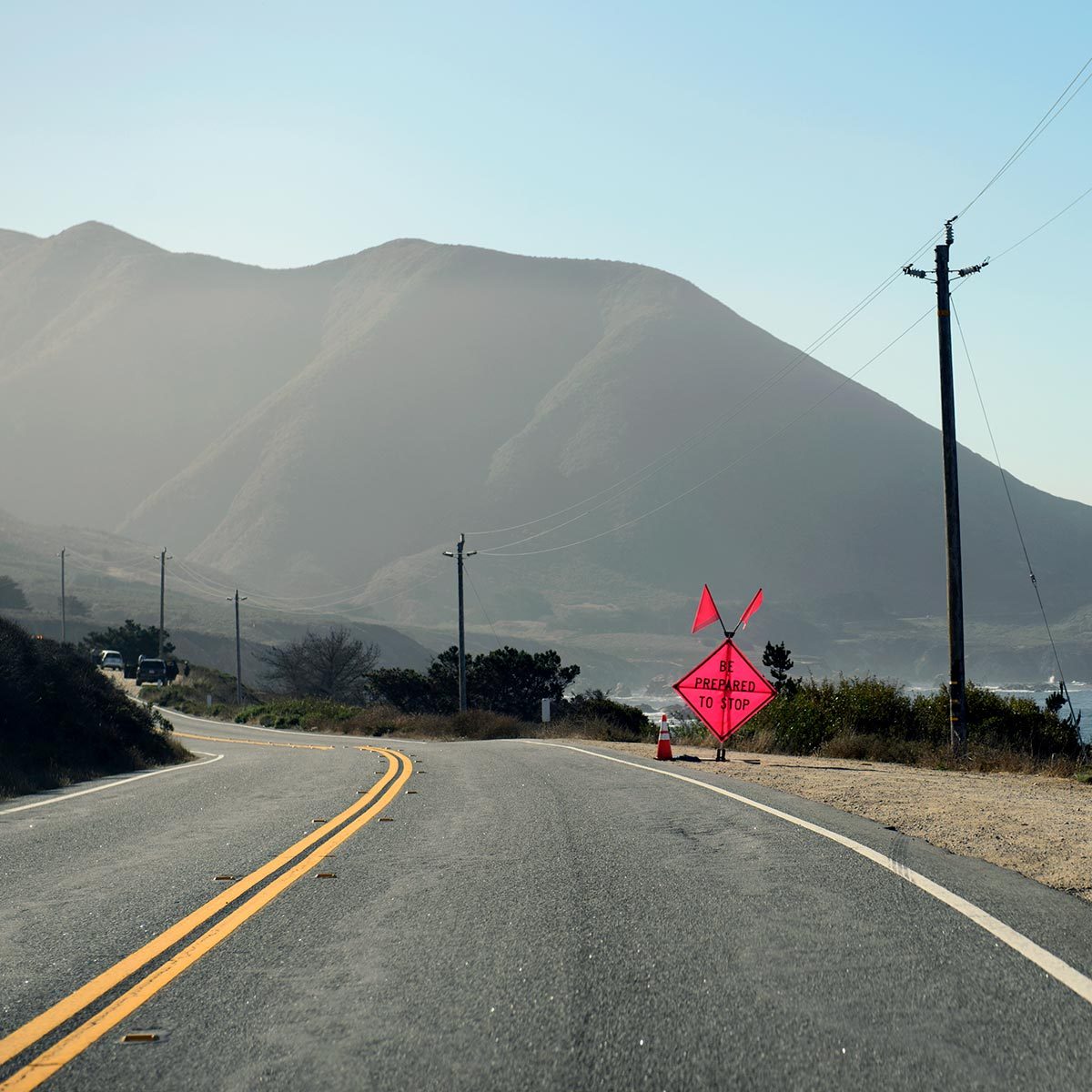A pink traffic sign may seem like a whimsical choice, but it’s actually trying to tell you something important

Here’s What It Means If You See a Pink Traffic Sign

As kids, we learn the basic rules of the road using three distinct colors: red, green and yellow. Their safety connotations are ingrained in our brains from early on. So if you’ve ever spotted a pink traffic sign, you’re probably wondering when the heck that came into play.
Unlike the elusive blue stop sign, pink traffic signs are more common than you think. And no, you don’t have to hit up the Happiest Place on Earth to see them, like you do with those purple Disney traffic signs. We spoke with Shashi Nambisan, PhD, director of the Transportation Research Center at the University of Nevada, Las Vegas, to dig up the details.
Read on to find out what pink means in the world of road safety—and how you should proceed if you encounter a pink traffic sign.
Also, find out the reason for the green lights on a car.
Get Reader’s Digest’s Read Up newsletter for more interesting facts, humor, cleaning, travel and tech all week long.
Why are some traffic signs pink?
Pink traffic signs let drivers know that there’s an incident or accident ahead, and they help manage the flow of traffic that’s being interrupted by something unexpected. “According to the Manual on Uniform Traffic Control Devices, [officials] allow for fluorescent pink only in the case of emergency signs for incident management,” says Nambisan. “Anywhere else, pink is not an approved color on public roads.”
While this road sign may seem confusing at first, its color simply indicates that the situation at hand is unplanned (so it’s not, say, a construction project), and it may require a detour or special attention of some kind. You’ll often see pink traffic signs with messages like “Road Closed,” “Detour” or “Incident Ahead.”
What do pink traffic signs mean?

Pink traffic signs mean that you should anticipate slowing down, either because of an accident or an obstacle on the road. These signs are usually diamond shaped, and more often than not, they’re a hot pink (not a bubblegum hue) with bold black lettering. “Fluorescent pink will get people’s attention because we don’t use it commonly, so the color indicates there must be some major emergency,” Nambisan says. “While the background is likely to be fluorescent pink, the lettering will say what the actual emergency is.”
Here are a few examples:
- Be Prepared to Stop: This typically involves an accident or an unplanned incident, like a fallen tree in the road.
- Center Lane Closed Ahead: It may be due to a stalled car, an accident or large debris in the road that presents an obstacle.
- Detour: This might be the result of an accident, flooding or other unplanned incident.
Then there are the more extreme possibilities. For example, says Nambisan, “the sign could say there’s a radioactive leak or biological hazard.”
What should you do if you see a pink traffic sign?
First and foremost, pay attention to it. It’s not on the side of the road to add a dash of rosiness to your day. Because a pink traffic sign indicates that officials are attempting to manage a situation, you’ll want to slow down and follow whatever direction it offers.
If the sign denotes a detour, you’ll need to get off at that exit. Not doing so could lead to a traffic violation, a safety hazard or other problems. The good news? That detour will (hopefully) put you right back where you need to go, as soon as the route is safe.
What’s the difference between pink traffic signs and yellow or orange road signs?
As noted earlier, a pink traffic sign means there’s an unplanned traffic incident ahead. Orange traffic signs, on the other hand, pop up when there’s construction or road maintenance—activities that the Department of Transportation knows about in advance. So, yes, you might see an orange detour or closed-lane sign, and that’s because whatever is happening has been planned for some time.
Yellow road signs, however, are a general warning of potentially hazardous conditions. For example, if you’re driving on a windy road with sharp turns, there might be a yellow sign to indicate the curvature ahead. Or a yellow sign could even note you’re in a location that often has high-wind advisories. A yellow stop sign is a different story, though—that’s actually a throwback to the early days of traffic control, before stop signs universally became red.
Regardless of their color, these signs attempt to give you essential information, and generally speaking, you’ll need to slow down and possibly adjust your driving or your route. By knowing the meaning of these colors, you’ll have a better idea of what’s ahead so you can get to your destination swiftly and safely.
About the expert
|
Why trust us
Reader’s Digest has published hundreds of travel stories that help readers explore the world safely, easily and affordably. We regularly cover topics such as the best places to visit (and the best times to visit them), tips and tricks to zoom through airport security, flight-attendant secrets, hotel-room hacks and more. We’re committed to producing high-quality content by writers with expertise and experience in their field in consultation with relevant, qualified experts. We rely on reputable primary sources, including government and professional organizations and academic institutions as well as our writers’ personal experiences where appropriate. We verify all facts and data, back them with credible sourcing and revisit them over time to ensure they remain accurate and up to date. Read more about our team, our contributors and our editorial policies.
Sources:
- Shashi Nambisan, PhD, director of the Transportation Research Center and professor in the Department of Civil and Environmental Engineering at the University of Nevada, Las Vegas; phone interview, Jan. 8, 2025
- Manual on Uniform Traffic Control Devices for Streets and Highways























